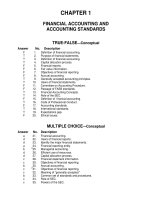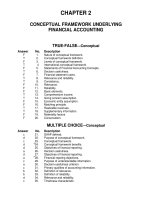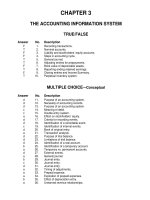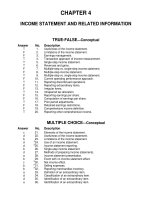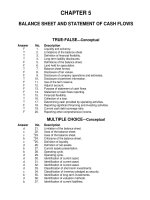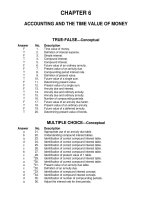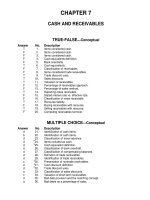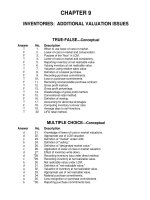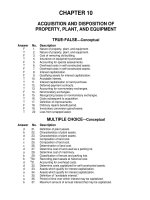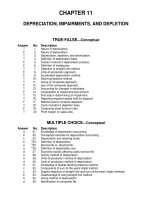Test bank with answers intermediate accounting 12e by kieso chapter 04
Bạn đang xem bản rút gọn của tài liệu. Xem và tải ngay bản đầy đủ của tài liệu tại đây (99.81 KB, 34 trang )
To download more slides, ebook, solutions and test bank, visit
CHAPTER 4
INCOME STATEMENT AND RELATED INFORMATION
TRUE-FALSE—Conceptual
Answer
T
F
F
T
T
T
F
F
T
F
T
F
F
T
F
F
T
F
F
T
No.
Description
1.
2.
3.
4.
5.
6.
7.
8.
9.
10.
11.
12.
13.
14.
15.
16.
17.
18.
19.
20.
Usefulness of the income statement.
Limitations of the income statement.
Earnings management.
Transaction approach of income measurement.
Single-step income statement.
Revenues and gains.
Multiple-step vs. single-step income statement.
Multiple-step income statement.
Multiple-step vs. single-step income statement.
Current operating performance approach.
Reporting discontinued operations.
Reporting extraordinary items.
Irregular items.
Intraperiod tax allocation.
Reporting earnings per share.
Computation of earnings per share.
Prior period adjustments.
Retained earnings restrictions.
Comprehensive income definition.
Reporting other comprehensive income.
MULTIPLE CHOICE—Conceptual
Answer
c
d
b
d
d
b
d
a
b
c
b
b
a
d
d
a
No.
21.
22.
23.
S
24.
S
25.
26.
27.
28.
29.
S
30.
P
31.
P
32.
33.
34.
35.
36.
Description
Elements of the income statement.
Usefulness of the income statement.
Limitations of the income statement.
Use of an income statement.
Income statement reporting.
Single-step income statement.
Methods of preparing income statements.
Income statement presentation.
Event with no income statement effect.
Net income effect.
Selling expenses.
Reporting merchandise inventory.
Definition of an extraordinary item.
Classification of an extraordinary item.
Identification of an extraordinary item.
Identification of an extraordinary item.
To download more slides, ebook, solutions and test bank, visit
Test Bank for Intermediate Accounting, Twelfth Edition
4-2
MULTIPLE CHOICE—Conceptual (cont.)
Answer
d
a
d
d
c
c
d
d
c
c
d
c
d
d
c
c
No.
37.
38.
39.
40.
41.
42.
43.
44.
S
45.
S
46.
P
47.
48.
49.
50.
51.
52.
Description
Identification of an extraordinary item.
Presentation of unusual or infrequent items.
Identification of a change in accounting principle.
Classification of extraordinary items.
EPS disclosures on income statement.
Reporting discontinued operations.
Intraperiod tax allocation.
Purpose of intraperiod tax allocation.
Reporting unusual or infrequent items.
Earnings per share disclosure.
Reporting correction of an error.
Retained earnings statement.
Prior period adjustment.
Identification of a prior period adjustment.
Comprehensive income items.
Providing information about components of comprehensive income.
MULTIPLE CHOICE—Computational
Answer
a
c
c
c
a
a
a
a
c
b
a
b
c
c
c
c
c
a
b
c
d
d
d
a
P
S
No.
Description
53.
54.
55.
56.
57.
58.
59.
60.
61.
62.
63.
64.
65.
66.
67.
68.
69.
70.
71.
72.
73.
74.
75.
76.
Single-step income statement.
Multiple-step income statement.
Multiple-step income statement.
Calculation of net sales.
Presentation of gain on sale of plant assets.
Extraordinary items.
Extraordinary items.
Calculate income before extraordinary items.
Calculate income before taxes and extraordinary items.
Calculate extraordinary loss.
Events affecting income from continuing operations.
Calculation of events affecting net income.
Disposal of a major business component.
Tax effect on irregular items.
Tax effect on irregular items.
Earnings per share.
Earnings per share.
Retained earnings statement.
Retained earnings statement.
Retained earnings statement.
Retained earnings statement.
Calculate balance of retained earnings.
Calculate other comprehensive income.
Calculate comprehensive income.
Note: these questions also appear in the Problem-Solving Survival Guide.
Note: these questions also appear in the Study Guide.
To download more slides, ebook, solutions and test bank, visit
Income Statement and Related Information
MULTIPLE CHOICE—CPA Adapted
Answer
d
a
a
a
d
c
a
b
a
b
No.
Description
77.
78.
79.
80.
81.
82.
83.
84.
85.
86.
Calculate selling expenses.
Calculate general and administrative expenses.
Calculate selling expenses.
Calculate general and administrative expenses.
Calculate cost of goods manufactured.
Calculate income before extraordinary item.
Determine extraordinary loss.
Determine infrequent gains not extraordinary.
Determine infrequent losses not extraordinary.
Identification of prior period adjustment.
EXERCISES
Item
Description
E4-87
E4-88
E4-89
E4-90
E4-91
E4-92
E4-93
E4-94
E4-95
Definitions.
Terminology.
Income statement disclosures.
Calculate net income from change in stockholders’ equity.
Calculate net income from change in stockholders’ equity.
Income statement classifications.
Income statement relationships.
Multiple-step income statement.
Classification of income and retained earnings statement items.
PROBLEMS
Item
Description
P4-96
P4-97
P4-98
P4-99
P4-100
Multiple-step income statement.
Income statement form.
Multiple-step income statement.
Single-step income statement.
Income statement and retained earnings statement.
CHAPTER LEARNING OBJECTIVES
1.
Understand the uses and limitations of an income statement.
2.
Prepare a single-step income statement.
3.
Prepare a multiple-step income statement.
4.
Explain how to report irregular items.
5.
Explain intraperiod tax allocation.
6.
Identify where to report tax earnings per share information.
7.
Prepare a retained earnings statement.
8.
Explain how to report other comprehensive income.
4-3
To download more slides, ebook, solutions and test bank, visit
4-4
Test Bank for Intermediate Accounting, Twelfth Edition
SUMMARY OF LEARNING OBJECTIVES BY QUESTIONS
Item
Type
Item
Type
Item
1.
2.
TF
TF
3.
4.
TF
TF
21.
22.
5.
TF
6.
TF
26.
7.
8.
9.
27.
TF
TF
TF
MC
28.
29.
S
30.
P
31.
MC
MC
MC
MC
P
10.
11.
12.
13.
33.
34.
TF
TF
TF
TF
MC
MC
35.
36.
37.
38.
39.
40.
MC
MC
MC
MC
MC
MC
41.
42.
S
45.
58.
59.
60.
14.
43.
TF
MC
44.
66.
MC
MC
67.
88.
15.
16.
TF
TF
41.
46.
MC
MC
68.
69.
17.
18.
P
47.
TF
TF
MC
48.
49.
50.
MC
MC
MC
70.
71.
72.
19.
TF
20.
TF
51.
Note:
S
32.
54.
55.
56.
TF = True-False
MC = Multiple Choice
Type
Item
Type
Item
Learning Objective 1
S
MC
23. MC
25.
S
MC
24. MC
87.
Learning Objective 2
MC
53. MC
99.
Learning Objective 3
MC
57. MC
80.
MC
77. MC
81.
MC
78. MC
82.
MC
79. MC
92.
Learning Objective 4
MC
61. MC
82.
MC
62. MC
83.
MC
63. MC
84.
MC
64. MC
85.
MC
65. MC
87.
MC
80. MC
88.
Learning Objective 5
MC
96.
P
98.
E
97.
P
99.
Learning Objective 6
MC
87.
E
98.
MC
96.
P
99.
Learning Objective 7
MC
73. MC
87.
MC
74. MC
88.
MC
86. MC
95.
Learning Objective 8
MC
52. MC
75.
E = Exercise
P = Problem
Type
MC
E
Item
Type
Item
Type
88.
89.
E
E
90.
91.
E
E
MC
MC
MC
E
93.
94.
95.
96.
E
E
E
P
98.
100.
P
P
MC
MC
MC
MC
E
E
95.
96.
97.
98.
99.
100.
E
P
P
P
P
P
P
P
100.
P
P
P
100.
P
E
E
E
99.
100.
P
P
MC
76.
MC
P
To download more slides, ebook, solutions and test bank, visit
Income Statement and Related Information
4-5
TRUE-FALSE—Conceptual
1. The income statement is useful for helping to assess the risk or uncertainty of achieving
future cash flows.
2. A strength of the income statement as compared to the balance sheet is that items that
cannot be measured reliably can be reported in the income statement.
3. Earnings management generally makes income statement information more useful for
predicting future earnings and cash flows.
4. The transaction approach of income measurement focuses on the income-related activities
that have occurred during the period.
5. Companies frequently report income tax expense as the last item before net income on a
single-step income statement.
6. Both revenues and gains increase both net income and owners’ equity.
7. Use of a multiple-step income statement will result in the company reporting a higher net
income than if they used a single-step income statement.
8. The primary advantage of the multiple-step format lies in the simplicity of presentation and
the absence of any implication that one type of revenue or expense item has priority over
another.
9. Gross profit and income from operations are reported on a multiple-step but not a singlestep income statement.
10. The accounting profession has adopted a current operating performance approach to
income reporting.
11. Companies report the results of operations of a component of a business that will be
disposed of separately from continuing operations.
12. Gains or losses from exchange or translation of foreign currencies are reported as
extraordinary items.
13. Discontinued operations, extraordinary items, and unusual gains and losses are all reported
net of tax in the income statement.
14. Intraperiod tax allocation relates the income tax expense of the period to the specific items
that give rise to the amount of the tax provision.
15. A company that reports a discontinued operation or an extraordinary item has the option of
reporting per share amounts for these items.
16. Dividends declared on common and preferred stock are subtracted from net income in the
computation of earnings per share.
To download more slides, ebook, solutions and test bank, visit
Test Bank for Intermediate Accounting, Twelfth Edition
4-6
17. Prior period adjustments can either be added or subtracted in the Retained Earnings
Statement.
18. Companies only restrict retained earnings to comply with contractual requirements or
current necessity.
19. Comprehensive income includes all changes in equity during a period except those
resulting from distributions to owners.
20. The components of other comprehensive income can be reported in a statement of
stockholders’ equity.
True False Answers—Conceptual
Item
1.
2.
3.
4.
5.
Ans.
T
F
F
T
T
Item
6.
7.
8.
9.
10.
Ans.
T
F
F
T
F
Item
11.
12.
13.
14.
15.
Ans.
T
F
F
T
F
Item
16.
17.
18.
19.
20.
Ans.
F
T
F
F
T
MULTIPLE CHOICE—Conceptual
21.
The major elements of the income statement are
a. revenue, cost of goods sold, selling expenses, and general expense.
b. operating section, nonoperating section, discontinued operations, extraordinary items,
and cumulative effect.
c. revenues, expenses, gains, and losses.
d. all of these.
22.
Information in the income statement helps users to
a. evaluate the past performance of the enterprise.
b. provide a basis for predicting future performance.
c. help assess the risk or uncertainty of achieving future cash flows.
d. all of these.
23.
Limitations of the income statement include all of the following except
a. items that cannot be measured reliably are not reported.
b. only actual amounts are reported in determining net income.
c. income measurement involves judgment.
d. income numbers are affected by the accounting methods employed.
S
24.
Which of the following would represent the least likely use of an income statement
prepared for a business enterprise?
a. Use by customers to determine a company's ability to provide needed goods and
services.
b. Use by labor unions to examine earnings closely as a basis for salary discussions.
c. Use by government agencies to formulate tax and economic policy.
d. Use by investors interested in the financial position of the entity.
To download more slides, ebook, solutions and test bank, visit
Income Statement and Related Information
S
4-7
25.
The income statement reveals
a. resources and equities of a firm at a point in time.
b. resources and equities of a firm for a period of time.
c. net earnings (net income) of a firm at a point in time.
d. net earnings (net income) of a firm for a period of time.
26.
The single-step income statement emphasizes
a. the gross profit figure.
b. total revenues and total expenses.
c. extraordinary items and accounting changes more than these are emphasized in the
multiple-step income statement.
d. the various components of income from continuing operations.
27.
Which of the following is an acceptable method of presenting the income statement?
a. A single-step income statement
b. A multiple-step income statement
c. A consolidated statement of income
d. All of these
28.
Which of the following is not a generally practiced method of presenting the income
statement?
a. Including prior period adjustments in determining net income
b. The single-step income statement
c. The consolidated statement of income
d. Including gains and losses from discontinued operations of a component of a business
in determining net income
29.
The occurrence which most likely would have no effect on 2007 net income (assuming
that all amounts involved are material) is the
a. sale in 2007 of an office building contributed by a stockholder in 1983.
b. collection in 2007 of a receivable from a customer whose account was written off in
2006 by a charge to the allowance account.
c. settlement based on litigation in 2007 of previously unrecognized damages from a
serious accident which occurred in 2005.
d. worthlessness determined in 2007 of stock purchased on a speculative basis in 2003.
S
30.
P
The occurrence that most likely would have no effect on 2007 net income is the
a. sale in 2007 of an office building contributed by a stockholder in 1961.
b. collection in 2007 of a dividend from an investment.
c. correction of an error in the financial statements of a prior period discovered
subsequent to their issuance.
d. stock purchased in 1993 deemed worthless in 2007.
31. Which of the following is not a selling expense?
a. Advertising expense
b. Office salaries expense
c. Freight-out
d. Store supplies consumed
To download more slides, ebook, solutions and test bank, visit
4-8
P
Test Bank for Intermediate Accounting, Twelfth Edition
32.
The accountant for the Orion Sales Company is preparing the income statement for 2007
and the balance sheet at December 31, 2007. The January 1, 2007 merchandise
inventory balance will appear
a. only as an asset on the balance sheet.
b. only in the cost of goods sold section of the income statement.
c. as a deduction in the cost of goods sold section of the income statement and as a
current asset on the balance sheet.
d. as an addition in the cost of goods sold section of the income statement and as a
current asset on the balance sheet.
33.
In order to be classified as an extraordinary item in the income statement, an event or
transaction should be
a. unusual in nature, infrequent, and material in amount.
b. unusual in nature and infrequent, but it need not be material.
c. infrequent and material in amount, but it need not be unusual in nature.
d. unusual in nature and material, but it need not be infrequent.
34.
Classification as an extraordinary item on the income statement would be appropriate for
the
a. gain or loss on disposal of a component of the business.
b. substantial write-off of obsolete inventories.
c. loss from a strike.
d. none of these.
35.
Which of these is generally an example of an extraordinary item?
a. Loss incurred because of a strike by employees.
b. Write-off of deferred marketing costs believed to have no future benefit.
c. Gain resulting from the devaluation of the U.S. dollar.
d. Gain resulting from the state exercising its right of eminent domain on a piece of land
used as a parking lot.
36.
Under which of the following conditions would material flood damage be considered an
extraordinary item for financial reporting purposes?
a. Only if floods in the geographical area are unusual in nature and occur infrequently.
b. Only if the flood damage is material in amount and could have been reduced by
prudent management.
c. Under any circumstances as an extraordinary item.
d. Flood damage should never be classified as an extraordinary item.
37.
An item that should be classified as an extraordinary item is
a. write-off of goodwill.
b. gains from transactions involving foreign currencies.
c. losses from moving a plant to another city.
d. gains from a company selling the only investment it has ever owned.
38.
How should an unusual event not meeting the criteria for an extraordinary item be
disclosed in the financial statements?
a. Shown as a separate item in operating revenues or expenses if material and supplemented by a footnote if deemed appropriate.
b. Shown in operating revenues or expenses if material but not shown as a separate item.
c. Shown net of income tax after ordinary net earnings but before extraordinary items.
d. Shown net of income tax after extraordinary items but before net earnings.
To download more slides, ebook, solutions and test bank, visit
Income Statement and Related Information
4-9
39.
Which of the following is a change in accounting principle?
a. A change in the estimated service life of machinery
b. A change from FIFO to LIFO
c. A change from straight-line to double-declining-balance
d. A change from FIFO to LIFO and a change from straight-line to double-decliningbalance
40.
Which of the following is never classified as an extraordinary item?
a. Losses from a major casualty.
b. Losses from an expropriation of assets.
c. Gain on a sale of the only security investment a company has ever owned.
d. Losses from exchange or translation of foreign currencies.
41.
Which of the following is a required disclosure in the income statement when reporting the
disposal of a component of the business?
a. The gain or loss on disposal should be reported as an extraordinary item.
b. Results of operations of a discontinued component should be disclosed immediately
below extraordinary items.
c. Earnings per share from both continuing operations and net income should be
disclosed on the face of the income statement.
d. The gain or loss on disposal should not be segregated, but should be reported together
with the results of continuing operations.
42.
When a company discontinues an operation and disposes of the discontinued operation
(component), the transaction should be included in the income statement as a gain or loss
on disposal reported as
a. a prior period adjustment.
b. an extraordinary item.
c. an amount after continuing operations and before extraordinary items.
d. a bulk sale of plant assets included in income from continuing operations.
43.
Income taxes are allocated to
a. extraordinary items.
b. discontinued operations.
c. prior period adjustments.
d. all of these.
44.
Which of the following is true about intraperiod tax allocation?
a. It arises because certain revenue and expense items appear in the income statement
either before or after they are included in the tax return.
b. It is required for extraordinary items and cumulative effect of accounting changes but
not for prior period adjustments.
c. Its purpose is to allocate income tax expense evenly over a number of accounting
periods.
d. Its purpose is to relate the income tax expense to the items which affect the amount of
tax.
To download more slides, ebook, solutions and test bank, visit
4 - 10
S
45.
Test Bank for Intermediate Accounting, Twelfth Edition
A material item which is unusual in nature or infrequent in occurrence, but not both should
be shown in the income statement
a.
b.
c.
d.
Net of Tax
No
Yes
No
Yes
Disclosed Separately
No
Yes
Yes
No
S
Earnings per share should always be shown separately for
a. net income and gross margin.
b. net income and pretax income.
c. income before extraordinary items.
d. extraordinary items and prior period adjustments.
P
A correction of an error in prior periods' income will be reported
46.
47.
a.
b.
c.
d.
In the income statement
Yes
No
Yes
No
Net of tax
Yes
No
No
Yes
48.
Which of the following items will not appear in the retained earnings statement?
a. Net loss
b. Prior period adjustment
c. Discontinued operations
d. Dividends
49.
Which one of the following types of losses is excluded from the determination of net
income in income statements?
a. Material losses resulting from transactions in the company's investments account.
b. Material losses resulting from unusual sales of assets not acquired for resale.
c. Material losses resulting from the write-off of intangibles.
d. Material losses resulting from correction of errors related to prior periods.
50.
Shank Corporation made a very large arithmetical error in the preparation of its year-end
financial statements by improper placement of a decimal point in the calculation of
depreciation. The error caused the net income to be reported at almost double the proper
amount. Correction of the error when discovered in the next year should be treated as
a. an increase in depreciation expense for the year in which the error is discovered.
b. a component of income for the year in which the error is discovered, but separately
listed on the income statement and fully explained in a note to the financial
statements.
c. an extraordinary item for the year in which the error was made.
d. a prior period adjustment.
51.
Comprehensive income includes all of the following except
a. dividend revenue.
b. losses on disposal of assets.
c. investments by owners.
d. unrealized holding gains.
To download more slides, ebook, solutions and test bank, visit
Income Statement and Related Information
52.
4 - 11
The approach most companies use to provide information related to the components of
other comprehensive income is a
a. second separate income statement.
b. combined income statement of comprehensive income.
c. separate column in the statement of changes in stockholders’ equity.
d. footnote disclosure.
Multiple Choice Answers—Conceptual
Item
21.
22.
23.
24.
25.
Ans.
c
d
d
d
d
Item
26.
27.
28.
29.
30.
Ans.
b
d
a
b
c
Item
31.
32.
33.
34.
35.
Ans.
b
b
a
d
d
Item
36.
37.
38.
39.
40.
Ans.
a
d
a
d
d
Item
41.
42.
43.
44.
45.
Ans.
c
c
d
d
c
Item
46.
47.
48.
49.
50.
Solution to Multiple Choice question for which the answer is “none of these.”
34.
Many answers are possible.
MULTIPLE CHOICE—Computational
53.
For Garret Wolfe Company, the following information is available:
Cost of goods sold
Dividend revenue
Income tax expense
Operating expenses
Sales
$ 60,000
2,500
6,000
23,000
100,000
In Garret Wolfe’s single-step income statement, gross profit
a. should not be reported.
b. should be reported at $13,500.
c. should be reported at $40,000.
d. should be reported at $42,500.
54.
For Garret Wolfe Company, the following information is available:
Cost of goods sold
Dividend revenue
Income tax expense
Operating expenses
Sales
$ 60,000
2,500
6,000
23,000
100,000
In Garret Wolfe’s multiple-step income statement, gross profit
a. should not be reported
b. should be reported at $13,500.
c. should be reported at $40,000.
d. should be reported at $42,500.
Ans.
Item
Ans.
c
d
c
d
d
51.
52.
c
c
To download more slides, ebook, solutions and test bank, visit
4 - 12
55.
Test Bank for Intermediate Accounting, Twelfth Edition
For Merando Company, the following information is available:
Cost of goods sold
Dividend revenue
Income tax expense
Operating expenses
Sales
$ 90,000
4,000
9,000
35,000
150,000
In Merando’s multiple-step income statement, gross profit
a. should not be reported
b. should be reported at $20,000.
c. should be reported at $60,000.
d. should be reported at $64,000.
56.
Gross billings for merchandise sold by Otto Company to its customers last year amounted
to $15,720,000; sales returns and allowances were $370,000, sales discounts were
$175,000, and freight-out was $140,000. Net sales last year for Otto Company were
a. $15,720,000.
b. $15,350,000.
c. $15,175,000.
d. $15,035,000.
57.
If plant assets of a manufacturing company are sold at a gain of $820,000 less related
taxes of $250,000, and the gain is not considered unusual or infrequent, the income
statement for the period would disclose these effects as
a. a gain of $820,000 and an increase in income tax expense of $250,000.
b. operating income net of applicable taxes, $570,000.
c. a prior period adjustment net of applicable taxes, $570,000.
d. an extraordinary item net of applicable taxes, $570,000.
58.
Sam Hurd Company has the following items: write-down of inventories, $120,000; loss on
disposal of Sports Division, $185,000; and loss due to strike, $113,000. Ignoring income
taxes, what total amount should Sam Hurd Company report as extraordinary losses?
a. $ -0-.
b. $185,000.
c. $233,000.
d. $298,000.
59.
Fleming Company has the following items: write-down of inventories, $240,000; loss on
disposal of Sports Division, $370,000; and loss due to an expropriation, $226,000.
Ignoring income taxes, what total amount should Fleming Company report as
extraordinary losses?
a. $226,000
b. $370,000.
c. $466,000.
d. $596,000.
To download more slides, ebook, solutions and test bank, visit
Income Statement and Related Information
4 - 13
60.
An income statement shows “income before income taxes and extraordinary items” in the
amount of $2,055,000. The income taxes payable for the year are $1,080,000, including
$360,000 that is applicable to an extraordinary gain. Thus, the “income before
extraordinary items” is
a. $1,335,000.
b. $615,000.
c. $1,395,000.
d. $675,000.
61.
Cole Company, with an applicable income tax rate of 30%, reported net income of
$210,000. Included in income for the period was an extraordinary loss from flood damage
of $30,000 before deducting the related tax effect. The company's income before income
taxes and extraordinary items was
a. $240,000.
b. $300,000.
c. $330,000.
d. $231,000.
62.
A review of the December 31, 2007, financial statements of Baden Corporation revealed
that under the caption "extraordinary losses," Baden reported a total of $515,000. Further
analysis revealed that the $515,000 in losses was comprised of the following items:
(1) Baden recorded a loss of $150,000 incurred in the abandonment of equipment
formerly used in the business.
(2) In an unusual and infrequent occurrence, a loss of $250,000 was sustained as a
result of hurricane damage to a warehouse.
(3) During 2007, several factories were shut down during a major strike by employees,
resulting in a loss of $85,000.
(4) Uncollectible accounts receivable of $30,000 were written off as uncollectible.
Ignoring income taxes, what amount of loss should Baden report as extraordinary on its
2007 income statement?
a. $150,000.
b. $250,000.
c. $400,000.
d. $515,000.
Use the following information for questions 63 and 64.
At Hall Company, events and transactions during 2007 included the following. The tax rate for all
items is 30%.
(1) Depreciation for 2005 was found to be understated by $30,000.
(2) A strike by the employees of a supplier resulted in a loss of $25,000.
(3) The inventory at December 31, 2005 was overstated by $40,000.
(4) A flood destroyed a building that had a book value of $500,000. Floods are very
uncommon in that area.
63.
The effect of these events and transactions on 2007 income from continuing operations
net of tax would be
a. $17,500.
b. $38,500.
c. $66,500.
d. $416,500.
To download more slides, ebook, solutions and test bank, visit
4 - 14
Test Bank for Intermediate Accounting, Twelfth Edition
64.
The effect of these events and transactions on 2007 net income net of tax would be
a. $17,500.
b. $367,500.
c. $388,500.
d. $416,500.
65.
During 2007, Gomez Corporation disposed of Pine Division, a major component of its
business. Gomez realized a gain of $1,200,000, net of taxes, on the sale of Pine's assets.
Pine's operating losses, net of taxes, were $1,400,000 in 2007. How should these facts
be reported in Gomez's income statement for 2007?
a.
b.
c.
d.
66.
Dan Nicholson Corporation has an extraordinary loss of $50,000, an unusual gain of
$35,000, and a tax rate of 40%. At what amount should Dan Nicholson report each item?
a.
b.
c.
d.
67.
Extraordinary loss
$(50,000)
(50,000)
(30,000)
(30,000)
Unusual gain
$35,000
21,000
35,000
21,000
Carpino Corporation has an extraordinary loss of $200,000, an unusual gain of $140,000,
and a tax rate of 40%. At what amount should Carpino report each item?
a.
b.
c.
d.
68.
Total Amount to be Included in
Income from
Results of
Continuing Operations
Discontinued Operations
$1,400,000 loss
$1,200,000 gain
200,000 loss
0
0
200,000 loss
1,200,000 gain
1,400,000 loss
Extraordinary loss
$(200,000)
(200,000)
(120,000)
(120,000)
Unusual gain
$140,000
84,000
140,000
84,000
Craig Rusch Corporation reports the following information:
Net income
Dividends on common stock
Dividends on preferred stock
Weighted average common shares outstanding
Rusch should report earnings per share of
a. $3.00.
b. $3.60
c. $4.40.
d. $5.00.
$500,000
140,000
60,000
100,000
To download more slides, ebook, solutions and test bank, visit
Income Statement and Related Information
69.
Edmonds Corporation reports the following information:
Net income
Dividends on common stock
Dividends on preferred stock
Weighted average common shares outstanding
$500,000
140,000
60,000
200,000
Edmonds should report earnings per share of
a. $1.50.
b. $1.80
c. $2.20.
d. $2.50.
70.
Simmons Corporation reports the following information:
Correction of understatement of depreciation expense
in prior years, net of tax
$ 430,000
Dividends declared
320,000
Net income
1,000,000
Retained earnings, 1/1/07, as reported
2,000,000
Simmons should report retained earnings, 1/1/07, as adjusted at
a. $1,570,000.
b. $2,000,000.
c. $2,430,000.
d. $3,110,000.
71.
Simmons Corporation reports the following information:
Correction of understatement of depreciation expense
in prior years, net of tax
$ 430,000
Dividends declared
320,000
Net income
1,000,000
Retained earnings, 1/1/07, as reported
2,000,000
Simmons should report retained earnings, 12/31/07, as adjusted at
a. $1,570,000.
b. $2,250,000.
c. $2,680,000.
d. $3,110,000.
72.
Joe Novak Corporation reports the following information:
Correction of overstatement of depreciation expense
in prior years, net of tax
$ 215,000
Dividends declared
160,000
Net income
500,000
Retained earnings, 1/1/07, as reported
1,000,000
Joe Novak should report retained earnings, 1/1/07, as adjusted at
a. $785,000.
b. $1,000,000.
c. $1,215,000.
d. $1,555,000.
4 - 15
To download more slides, ebook, solutions and test bank, visit
4 - 16
73.
Test Bank for Intermediate Accounting, Twelfth Edition
Joe Novak Corporation reports the following information:
Correction of overstatement of depreciation expense
in prior years, net of tax
$ 215,000
Dividends declared
160,000
Net income
500,000
Retained earnings, 1/1/07, as reported
1,000,000
Joe Novak should report retained earnings, 12/31/07, at
a. $785,000.
b. $1,125,000.
c. $1,340,000.
d. $1,555,000.
74.
The following information was extracted from the accounts of Boone Corporation at
December 31, 2007:
CR(DR)
Total reported income since incorporation
$1,700,000
Total cash dividends paid
(800,000)
Unrealized holding loss
(120,000)
Total stock dividends distributed
(200,000)
Prior period adjustment, recorded January 1, 2007
75,000
What should be the balance of retained earnings at December 31, 2007?
a. $655,000.
b. $700,000.
c. $580,000.
d. $775,000.
75.
Penn Company reported the following information for 2007:
Sales revenue
Cost of goods sold
Operating expenses
Unrealized holding gain on available-for-sale securities
Cash dividends received on the securities
$510,000
350,000
55,000
40,000
2,000
For 2007, Penn would report other comprehensive income of
a. $137,000.
b. $135,000.
c. $42,000.
d. $40,000.
76.
Silas Company reported the following information for 2007:
Sales revenue
Cost of goods sold
Operating expenses
Unrealized holding gain on available-for-sale securities
Cash dividends received on the securities
For 2007, Silas would report comprehensive income of
a. $117,000.
b. $115,000.
c. $97,000.
d. $20,000.
$500,000
350,000
55,000
20,000
2,000
To download more slides, ebook, solutions and test bank, visit
Income Statement and Related Information
4 - 17
Multiple Choice Answers—Computational
Item
53.
54.
55.
56.
Ans.
a
c
c
c
Item
57.
58.
59.
60.
Ans.
a
a
a
a
Item
61.
62.
63.
64.
Ans.
c
b
a
b
Item
65.
66.
67.
68.
Ans.
c
c
c
c
Item
69.
70.
71.
72.
Ans.
Item
Ans.
c
a
b
c
73.
74.
75.
76.
d
d
d
a
MULTIPLE CHOICE—CPA Adapted
Use the following information for questions 77 and 78.
Meyer Corp. reports operating expenses in two categories: (1) selling and (2) general and
administrative. The adjusted trial balance at December 31, 2007, included the following expense
accounts:
Accounting and legal fees
Advertising
Freight-out
Interest
Loss on sale of long-term investments
Officers' salaries
Rent for office space
Sales salaries and commissions
$140,000
120,000
75,000
60,000
30,000
180,000
180,000
110,000
One-half of the rented premises is occupied by the sales department.
77.
How much of the expenses listed above should be included in Meyer's selling expenses
for 2007?
a. $230,000.
b. $305,000.
c. $320,000.
d. $395,000.
78.
How much of the expenses listed above should be included in Meyer's general and
administrative expenses for 2007?
a. $410,000.
b. $440,000.
c. $470,000.
d. $500,000.
79.
Bowen Corp. reports operating expenses in two categories: (1) selling and (2) general and
administrative. The adjusted trial balance at December 31, 2007 included the following
expense and loss accounts:
To download more slides, ebook, solutions and test bank, visit
4 - 18
Test Bank for Intermediate Accounting, Twelfth Edition
Accounting and legal fees
Advertising
Freight-out
Interest
Loss on sale of long-term investment
Officers' salaries
Rent for office space
Sales salaries and commissions
$140,000
180,000
80,000
70,000
30,000
225,000
220,000
170,000
One-half of the rented premises is occupied by the sales department. Bowen's total selling
expenses for 2007 are
a. $540,000.
b. $460,000.
c. $430,000.
d. $370,000.
80.
The following items were among those that were reported on Nen Co.'s income statement
for the year ended December 31, 2007:
Legal and audit fees
$130,000
Rent for office space
180,000
Interest on inventory floor plan
210,000
Loss on abandoned equipment used in operations
35,000
The office space is used equally by Nen's sales and accounting departments. What
amount of the above-listed items should be classified as general and administrative
expenses in Nen's multiple-step income statement?
a. $220,000.
b. $255,000.
c. $310,000.
d. $430,000.
Use the following information for questions 81 through 83.
Hogan Corp.'s trial balance of income statement accounts for the year ended December 31, 2007
included the following:
Debit
Credit
Sales
$140,000
Cost of sales
$ 50,000
Administrative expenses
25,000
Loss on sale of equipment
9,000
Commissions to salespersons
8,000
Interest revenue
5,000
Freight-out
3,000
Loss due to earthquake damage
12,000
Bad debt expense
3,000
Totals
$110,000
$145,000
Other information:
Hogan's income tax rate is 30%. Finished goods inventory:
January 1, 2007
December 31, 2007
$80,000
70,000
To download more slides, ebook, solutions and test bank, visit
Income Statement and Related Information
4 - 19
On Hogan's multiple-step income statement for 2007,
81.
Cost of goods manufactured is
a. $63,000.
b. $60,000.
c. $43,000.
d. $40,000.
82.
Income before extraordinary item is
a. $64,000.
b. $47,000.
c. $32,900.
d. $24,500.
83.
Extraordinary loss is
a. $8,400.
b. $12,000.
c. $14,700.
d. $21,000.
84.
Agler Corp. had the following infrequent transactions during 2007:
A $150,000 gain from selling the only investment Agler has ever owned.
A $210,000 gain on the sale of equipment.
A $70,000 loss on the write-down of inventories.
In its 2007 income statement, what amount should Agler report as total infrequent net
gains that are not considered extraordinary?
a. $80,000.
b. $140,000.
c. $290,000.
d. $360,000.
85.
Snead, Inc. incurred the following infrequent losses during 2007:
A $70,000 write-down of equipment leased to others.
A $40,000 adjustment of accruals on long-term contracts.
A $60,000 write-off of obsolete inventory.
In its 2007 income statement, what amount should Snead report as total infrequent losses
that are not considered extraordinary?
a. $170,000.
b. $130,000.
c. $110,000.
d. $100,000.
86.
Which of the following should be reported as a prior period adjustment?
Change in Estimated Lives
of Depreciable Assets
a.
Yes
b.
No
c.
Yes
d.
No
Change from Unaccepted
Principle to Accepted Principle
Yes
Yes
No
No
To download more slides, ebook, solutions and test bank, visit
4 - 20
Test Bank for Intermediate Accounting, Twelfth Edition
Multiple Choice Answers—CPA Adapted
Item
77.
78.
Ans.
Item
d
a
79.
80.
Ans.
a
a
Item
81.
82.
Ans.
d
c
Item
Ans.
Item
Ans.
a
b
85.
86.
a
b
83.
84.
DERIVATIONS — Computational
No.
Answer
53.
a
Derivation
54.
c
$100,000 – $60,000 = $40,000.
55.
c
$150,000 – $90,000 = $60,000.
56.
c
$15,720,000 – $370,000 – $175,000 = $15,175,000.
57.
a
58.
a
59.
a
60.
a.
$2,055,000 – ($1,080,000 – $360,000) = $1,335,000.
61.
c
62.
b
$210,000 + ($30,000 × .7) = $231,000
$231,000 ÷ .7 = $330,000.
$515,000 – $150,000 – $85,000 – $30,000 = $250,000.
63.
a
$25,000 – $7,500 = $17,500.
64.
b
$17,500 + ($500,000 × .7) = $367,500.
65.
c
$1,400,000 – $1,200,000 = $200,000.
66.
c
$50,000 × .60 = $30,000.
67.
c
$200,000 × .60 = $120,000.
68.
c
($500,000 – $60,000) ÷ 100,000 = $4.40.
69.
c
($500,000 – $60,000) ÷ 200,000 = $2.20.
70.
a
$2,000,000 – $430,000 = $1,570,000.
71.
b
$2,000,000 – $430,000 + $1,000,000 – $320,000 = $2,250,000.
72.
c
$1,000,000 + $215,000 = $1,215,000.
To download more slides, ebook, solutions and test bank, visit
Income Statement and Related Information
No.
Answer
73.
d
$1,000,000 + $215,000 + $500,000 – $160,000 = $1,555,000.
74.
d
$1,700,000 – $800,000 – $200,000 + $75,000 = $775,000.
75.
d
Other comprehensive income = $40,000.
76.
a
$500,000 – $350,000 – $55,000 + $20,000 + $2,000 = $117,000.
4 - 21
Derivation
DERIVATIONS — CPA Adapted
No.
Answer
Derivation
77.
d
$120,000 + $75,000 + $110,000 + $90,000 = $395,000.
78.
a
$140,000 + $180,000 + $90,000 = $410,000.
79.
a
$180,000 + $80,000 + $110,000 + $170,000 = $540,000.
80.
a
$130,000 + $90,000 = $220,000.
81.
d
$50,000 + $70,000 – $80,000 = $40,000.
82.
c
$140,000 – $50,000 – $25,000 – $9,000 – $8,000 – $3,000 – $3,000 +
$5,000 – $14,100 = $32,900.
83.
a
$12,000 × 0.7 = $8,400.
84.
b
$210,000 – $70,000 = $140,000.
85.
a
$70,000 + $40,000 + $60,000 = $170,000.
86.
b
Conceptual.
To download more slides, ebook, solutions and test bank, visit
4 - 22
Test Bank for Intermediate Accounting, Twelfth Edition
EXERCISES
Ex. 4-87—Definitions.
Provide clear, concise answers for the following.
1. What are revenues?
2. What are expenses?
3. What are gains?
4. What are losses?
5. What are the criteria (in addition to materiality) that must be met to classify an event or
transaction as extraordinary?
6. When does a discontinued operation occur?
7. Indicate how earnings per share is computed.
8. State the primary category of prior period adjustments and indicate how they are reported in
the financial statements.
Solution 4-87
1. Revenues are increases in net assets during a period from delivering goods or services that
constitute the entity's major or central operations.
2. Expenses are the using-up of assets or other decreases in net assets during a period from
delivering goods or services that constitute the entity's major or central operations.
3. Gains are increases in net assets from peripheral transactions, events, or circumstances
affecting the entity except those resulting from revenues or investments by owners.
4. Losses are decreases in net assets from peripheral transactions, events, or circumstances
affecting the entity except those resulting from expenses or distributions to owners.
5. Both of the following criteria should be met to classify an item as extraordinary: (1) Unusual
nature, considering the environment, and (2) infrequent in occurrence, considering the
environment.
6. A discontinued operation occurs when (a) the results of operations and cash flows of a
component of a company have been eliminated from the ongoing operations, and (b) there is
no significant continuing involvement in that component after the disposal transaction.
7. The computation of earnings per share is: Net income minus preferred dividends divided by
the weighted average of common shares outstanding.
8. Prior period adjustments include correction of an error in the financial statements of a prior
period. Prior period adjustments (net of tax) should be charged or credited to the opening
balance of retained earnings.
To download more slides, ebook, solutions and test bank, visit
Income Statement and Related Information
4 - 23
Ex. 4-88—Terminology.
In the space provided, write the word or phrase that is defined or indicated.
1. Net income minus preferred dividends
divided by the weighted average of shares
outstanding.
1. ________________________________
2. All changes in equity during a period except
those resulting from investments by owners
and distributions to owners.
2. ________________________________
3. A correction of an error is reported as a
3. ________________________________
4. An event or transaction which is unusual
in nature and infrequent in occurrence.
4. ________________________________
5. The income statement category for a
disposal of a component of a business.
5. ________________________________
6. Relating tax expense to specific items
on the income statement.
6. ________________________________
Solution 4-88
1.
2.
3.
4.
5.
6.
Earnings per share.
Comprehensive income.
Prior period adjustment.
Extraordinary item.
Discontinued operations.
Intraperiod tax allocation.
Ex. 4-89—Income statement disclosures.
What is disclosed in an income statement? Be specific.
Solution 4-89
An income statement discloses revenues, expenses, gains, and losses. It discloses the net
income (loss) for a period and earnings per share data. The income statement may also include
discontinued operations (net of tax) and extraordinary items (net of tax).
To download more slides, ebook, solutions and test bank, visit
4 - 24
Test Bank for Intermediate Accounting, Twelfth Edition
Ex. 4-90—Calculation of net income from the change in stockholders' equity.
Presented below is certain information pertaining to Juan Company.
Assets, January 1
Assets, December 31
Liabilities, January 1
Common stock, December 31
Retained earnings, December 31
Common stock sold during the year
Dividends declared during the year
$240,000
230,000
150,000
80,000
31,000
10,000
13,000
Compute the net income for the year.
Solution 4-90
Assets
Liabilities
Stockholders' equity
Computation of net income:
Stockholders' equity December 31
Stockholders' equity January 1
Increase
Add: Dividend declared
Less: Common stock sold
Net income
January 1
$240,000
150,000
$ 90,000
December 31
$111,000*
$111,000
90,000
21,000
13,000
(10,000)
$ 24,000
*$80,000 + $31,000
Ex. 4-91—Calculation of net income from the change in stockholders' equity.
Presented below are changes in the account balances of Ping Company during the year, except
for retained earnings.
Increase
Increase
(Decrease)
(Decrease)
Cash
$29,000
Accounts payable
$34,000
Accounts receivable (net)
(13,000)
Bonds payable
(20,000)
Inventory
52,000
Common stock
72,000
Plant Assets (net)
37,000
Paid-in capital
16,000
The only entries in Retained Earnings were for net income and a dividend declaration of $12,000.
Compute the net income for the current year.
To download more slides, ebook, solutions and test bank, visit
Income Statement and Related Information
4 - 25
Solution 4-91
Computation of net income
Change in assets ($118,000 – $13,000)
Change in liabilities ($34,000 – $20,000)
Change in stockholders' equity
Add: Dividend declared
Less: Investment by stockholders
Net income
$105,000
14,000
91,000
12,000
(88,000)
$ 15,000
Increase
Increase
Increase
Ex. 4-92—Income statement classifications.
Indicate the major section or subsection of a multiple-step income statement in which each of the
following items would usually appear:
a. Advertising
b. Depletion
c. Dividend revenue
d. Freight-in
e. Loss on disposal of a component of the business, net of tax
f. Income taxes on income
g. Major casualty loss, net of tax
h. Purchase discounts
i. Sales discounts
j. Officers' salaries
k. Freight-out
l. Sinking fund income
Solution 4-92
a.
b.
c.
d.
e.
f.
g.
h.
i.
j.
k.
l.
Selling expense.
Cost of goods sold.
Other revenue.
Cost of goods sold as an addition to purchases.
Discontinued operations.
Income taxes; subtracted from income before income taxes in arriving at net income.
Extraordinary items.
Cost of goods sold as a subtraction from purchases.
Subtracted from gross revenues.
Administrative or general expenses.
Selling expense.
Other revenue.
